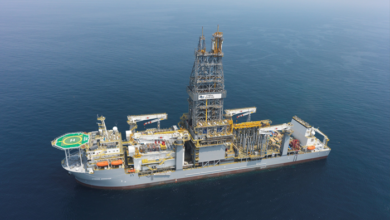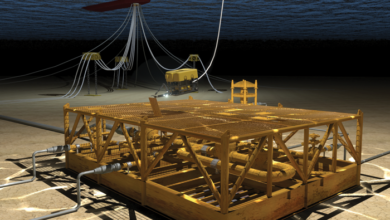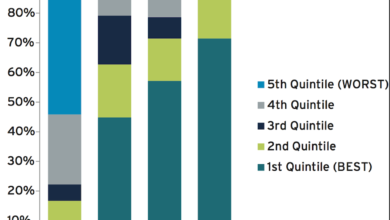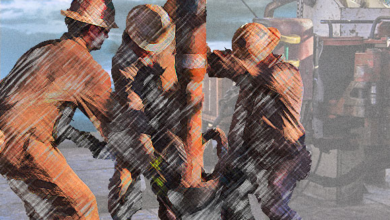Now more than ever, performance becomes the name of the game
Atwood Oceanics amps up focus on equipment reliability, personnel competency amid falling oil prices
By Linda Hsieh, Managing Editor
 Rob Saltiel has served as President and CEO of Atwood Oceanics since December 2009 and as a Director on the Board since February 2010.
Rob Saltiel has served as President and CEO of Atwood Oceanics since December 2009 and as a Director on the Board since February 2010.
As the industry heads into a downturn of uncertain length and severity, what is the focal point for offshore drilling contractors?
The focal point for our industry in 2015 is performance. As E&P operators’ capital expenditure budgets become more constrained due to lower oil prices, it is critical that we drill our wells as efficiently as possible. In 2015, Atwood Oceanics will be very focused on improving our performance through better equipment reliability and drilling efficiency to reduce the cost of our clients’ drilling programs.
How will you go about improving performance?
Performance improvement starts with ensuring a high degree of equipment reliability. This is accomplished by ensuring that we have competent people operating our rigs to minimize human error and that we implement effective maintenance programs to prevent equipment failures.

Atwood has invested significantly in the training and development of our offshore people. We recently received IADC accreditation of our Competency Assurance program after a detailed audit, so we have high confidence that our offshore personnel possess the knowledge and skills to be effective in performing their roles. We also maintain a development pool of employees who are receiving additional training – on the job and in the classroom – to advance their careers within our company.
We continue to improve our maintenance programs, with special emphasis on BOPs since downtime on floating rigs is predominantly due to the malfunction of a BOP or its control system. At Atwood, we have standardized all BOP equipment on our new rigs around a single manufacturer, so our technical support and vendor management processes can be much more focused and efficient. We use common procedures and provide extra supervision for the maintenance and testing of our BOPs. These efforts have resulted in fewer unplanned stack pulls and more time on bottom, which saves our clients time and money.
Just after reliability comes efficiency. Getting the most out of our latest-generation equipment allows us to drill wells faster without compromising safety or the environment. Recently, we have been successful in hopping our subsea BOPs between wells, both in the Gulf of Mexico and in Australia, to minimize the nonproductive time between wells. This activity has saved our clients millions of dollars and has significantly improved the economics of their drilling programs.
So you believe deepwater and ultra-deepwater drilling can still be economical even at these lower oil prices?
Certainly, but it will be more of a challenge since fewer programs will be attractive economically at lower oil price levels. That is why we must drill efficiently and eliminate nonproductive time to improve our clients’ economics. Of course, this has to be done without sacrificing safety or environmental performance.
Keep in mind that deepwater and ultra-deepwater developments typically produce significant hydrocarbon volumes for many years and, therefore, span more than one industry cycle. Also, every operator has a basic business need to maintain or increase its reserves and production. This can only happen through the drill bit, and some of the best opportunities still remain in deeper waters.
How can the industry ensure that it doesn’t lose focus on safety and operational integrity even during a down cycle?
The industry has learned a lot about the criticality of well control integrity from the Macondo incident. We are never going to lose this focus. Our expenditures on training, safety and well control integrity don’t move with cycles. This is true for Atwood and for our entire industry.
We’ve been through downturns before, so we know that we will come through on the other side. Over the longer run, our industry will not only survive, but thrive. The worst thing we can do is to cut the expenditures that are critical to the viability of our industry. At Atwood, we are certainly not going to do that.
How can collaboration with operators or other service companies help during downturns?
We must maintain a regular and open dialogue with our clients and suppliers, especially when times are difficult. When oil prices are high and rig demand is strong, everybody tends to get along. When things get more challenging, that’s when relationships differentiate themselves.
We meet regularly with our clients to understand their key drivers for success. We are always looking for opportunities to deliver lower-cost wells, especially when we know that budgets are under pressure. Because we are a smaller company, we can mobilize our resources efficiently and gain consensus rapidly when exploring cost-saving opportunities for our clients.
So you don’t think this downturn will impact the industry’s willingness to invest in its people?
Absolutely not. Our industry takes competency assurance very seriously. At Atwood, we have invested significantly in our personnel training because we know that, in order to guarantee the safety and quality of our operations, we must have people in all positions who understand their jobs and can perform them reliably and safely. Our Competency Assurance program provides a structured framework for ensuring that we are doing this.
On the flip side, what will it take to attract talent into this industry when we’re in a downturn?
When our industry is in a downturn, there is a risk that we will see a short-term contraction of our workforce. Our challenge is to retain as much talent as we can, given the difficult economic reality.
However, in the longer term, we will need new people with skills – not just to replace those who are retiring but also to bring new ideas and new energy to our business. As ambassadors for our industry, we must continue to emphasize the vitality and sustainability of our business. I think this message will always resonate with talented people.
What advice do you have for younger people who might have recently joined the industry and who may not be used to the ups and downs in this business?
Ours is a cyclical industry, and it always will be. For those who may have recently joined our industry, or for whom this may be their first downturn, some concern is understandable. For those of us who have been around since the 1980s, we have seen this a few times before.
I would advise the younger people to take a long-term view of our industry’s sustainability. We have been drilling oil and gas wells in the US for over 150 years, and we’ve been drilling offshore in the Gulf of Mexico for more than 65 years. Recognizing that these cycles are part of our industry – past, present and future – puts our current downturn into a meaningful context.
2015 will mark five years since Macondo. What changes have you seen the industry make to improve safety?
The Macondo incident really increased our industry’s focus on process safety. We already had a strong mindset about safety, but it was more around personal safety, that is, prevention of injuries to individuals. With Macondo, we learned the hard way that we must devote at least as much effort to the prevention of major incidents. They may be very infrequent, but their consequences are so high for the rig and the people onboard that they demand their own set of initiatives.
At Atwood, we have stressed well control integrity as our point of emphasis for our process safety plans. In addition to assuring the competence of all of our drillers, we have encouraged them repeatedly to shut the well in whenever they are concerned with what may be happening in the wellbore. We call this Stop Work Obligation – our people have not only the authority but also the obligation to shut in the well. They don’t need to gain consensus from others in the drillers’ cabin to do so. We want our drillers to err on the side of prudency, so even if a well shut-in turns out to have been unnecessary, we applaud their action.
We certainly have come a long way as well on the equipment side. We’re installing seven-ram BOP stacks on our four drillships, and we are insisting on full redundancy on all functions when drilling our wells. We’re installing new auto-shearing equipment on the BOPs of our older rigs to provide additional well control protection over what we’ve had for the past 20-plus years. The combination of better equipment and more stringent maintenance and testing procedures, coupled with a “100% redundancy” approach to BOP control systems, has gone a long way to improve well control integrity in the offshore drilling industry.
Have regulators seen the efforts the industry has made?
Absolutely. In the Gulf of Mexico, the Bureau of Safety and Environmental Enforcement (BSEE) visits our rigs regularly and observes how we work and how we maintain our well control equipment. They see the quality of our procedures and the focus on well control integrity and well control equipment maintenance. Our industry and the regulators are working cooperatively to achieve the same goals of safety and environmental responsibility.
What role can IADC play in helping drilling contractors to maintain well control integrity?
The more our industry can work together to share best practices and lessons learned, the better. We need to derive lessons from actual incidents, including near-misses, and install fixes to prevent them from recurring. IADC can be the conduit for sharing these lessons, perhaps by helping to preserve operator and contractor anonymity while still allowing the lessons learned to be shared widely.
Would the sharing of well control incidents or near-misses need to be operator-driven?
It would need to be industry driven, with offshore drillers working in partnership with operators. As an industry, we need to find a way to share the incidents that don’t necessarily put us in the best light, but from which we can learn. We can still do much more in this area.
How has the continued development of drilling automation impacted the industry’s approach to recruitment or training?
There’s no question that automation has brought many benefits to our industry. Drilling a well on a modern offshore rig is more akin to operating a computer or video game, with a joystick and a software interface. This requires individuals who are naturally comfortable with technology to operate, maintain and trouble-shoot our equipment.
This means we have to train our people differently, and we have to look at new sources for our recruiting. Our marine teams are already staffed with individuals from marine academies or advanced schools for navigation. For drilling, we may need to consider alternate career paths to the driller’s cyber-chair in order to assure that the technology angle of the job is well-covered. Our country’s military veterans often possess advanced technical and computer skills when they leave the service, so they have become another good source of future talent.
Atwood has invested significantly in newbuilds in recent years. What challenges have you addressed in the delivery of these newbuilds, and what lessons have you learned?
After our two remaining drillships under construction are delivered, we will have added a total of nine high-specification rigs to our fleet in approximately six years. For a company our size, that’s a tremendous transformation and modernization of our fleet. We have selected proven rig designs and world-class shipyards to construct our two ultra-deepwater semisubmersibles, three 400-ft Pacific-class jackups and four ultra-deepwater drillships. So far, we have been very pleased with our execution in delivering, starting up and operating these modern rigs.
One area where we have been successful has been in standardization. The drilling systems, BOPs, riser and many other equipment items are common across all of our new rigs. By standardizing, we have allowed our technical support team members to work very efficiently. For example, they can develop a single set of maintenance and testing procedures for our BOPs and maintain interchangeable spare parts and inventory to share among the nine rigs. This improves both our BOP reliability and our maintenance efficiency.
Standardization has helped immensely in the training of our people, especially since we are a growing company with many new faces. Because all of our new rigs have a common drilling package, a driller can be trained on a new semisubmersible, then move to a drillship and operate the same top drive and pipe handling system. This is a huge advantage for developing a common training platform and for facilitating career development of our offshore personnel across the fleet.
Any prospects on additional newbuilds at this point?
Obviously, during these uncertain times, we will proceed more cautiously with regards to growth. Our priority is to secure initial work for our two drillships under construction. Once we have confidence that we’re coming out of this downturn, we will shift our attention back to fleet growth opportunities.
The current downturn will definitely cause many older offshore rigs to permanently exit the market. Our industry has been discussing the bifurcation of asset quality for a while, where newer and more technically capable rigs work at a preference to older, less capable rigs. In 2015, I expect to see a large number of older rigs displaced by newer rigs or simply not renewed – both floaters and jackups – as we see a “flight to quality” among working drilling units. As older rigs leave the supply stack, it will create opportunities for new rigs down the road.
Top drives and BOPs remain the top two pieces of rig equipment for downtime. From your perspective, how have equipment manufacturers responded to this challenge? What more would you like to see them do?
Our focus needs to center on reliability if we are to perform at a high level for our clients. Our industry has not produced major rig equipment that works at the same level of reliability as, say, aircraft engines. We work in very harsh environments – up to 10,000 ft below the waterline, under tremendous pressures and temperatures, with high torques and heavy loads. It is not an easy place to work, but since the consequences of poor reliability can be extremely high in terms of safety, environment and cost, we must have reliable equipment.
Atwood’s technical services team members are working with our major equipment suppliers to assist them in producing equipment that is more robust and works the first time. We are also collaborating to develop and implement maintenance procedures to prevent failures from occurring. These efforts have helped Atwood make excellent progress in improving the reliability of our operations.
What other challenges do you see for the global drilling industry?
2014 was a particularly difficult year for worldwide exploration. A number of closely watched exploratory wells were unsuccessful – either dry holes or noncommercial – and no new exciting plays materialized. For our industry to be successful over the longer term, operators need a healthy level of exploration success that leads to future appraisal and development drilling. Most of the operators I have spoken with believe that 2014 was an aberration, so we are looking to 2015 to deliver better exploration results.
While 2015 will be a challenging year for our industry, Atwood Oceanics is well positioned to weather the downturn. We possess a young, high-specification drilling fleet, and our balance sheet is in good shape. We have just concluded a year of record revenues and near-record profits. Our strong backlog of contracts reduces our exposure to re-marketing our rigs in 2015. Most importantly, we have a growing and vibrant workforce that is passionate about offshore drilling and committed to delivering outstanding performance for our clients. If we continue to execute as we always have, we’ll be fine.




